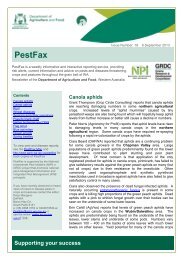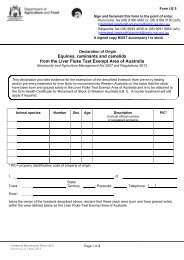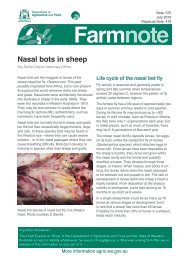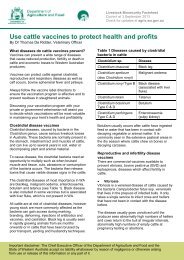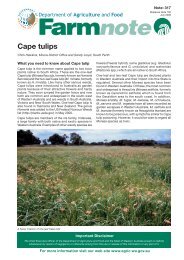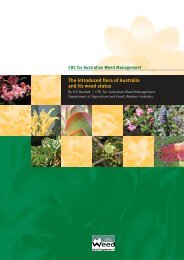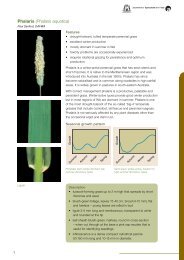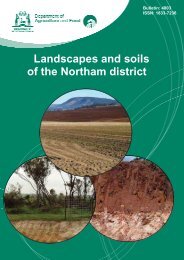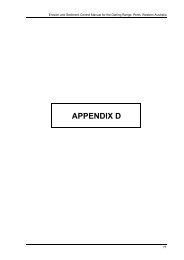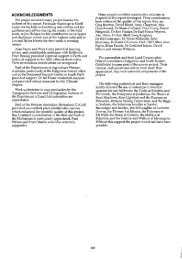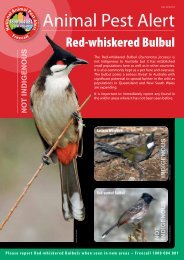Improving citrus fruit quality using gibberellic acid - Department of ...
Improving citrus fruit quality using gibberellic acid - Department of ...
Improving citrus fruit quality using gibberellic acid - Department of ...
You also want an ePaper? Increase the reach of your titles
YUMPU automatically turns print PDFs into web optimized ePapers that Google loves.
<strong>Improving</strong> <strong>citrus</strong> <strong>fruit</strong> <strong>quality</strong> <strong>using</strong><br />
Gibberellic Acid (GA)<br />
By George Morris, Technical Officer and Gavin Foord, Development Officer Citrus, South Perth<br />
Background<br />
Gibberellic Acid (GA) is a naturally occurring hormone<br />
or growth-regulating chemical that is found to varying<br />
degrees in all parts <strong>of</strong> a plant. The highest concentration<br />
occurs in the immature seed and is what stimulates<br />
<strong>fruit</strong> to grow. GA stimulates both cell division and cell<br />
elongation. Manufactured GA is a product that has been<br />
available for many years and there are several products<br />
available. GA is highly effective when applied at the right<br />
time and at the right concentration. GA can be used to<br />
alter the growth pattern <strong>of</strong> plants considerably.<br />
Why do we use GA on <strong>citrus</strong>?<br />
GA is used to reduce the incidence and/or severity <strong>of</strong><br />
some physiological disorders, that is disorders that<br />
occur due to environmental conditions not disease.<br />
There are four key reasons for <strong>using</strong> GA on <strong>citrus</strong>:<br />
1. Albedo breakdown (sometimes known as creasing)<br />
in Navel and Valencia oranges and grape<strong>fruit</strong>. Albedo<br />
breakdown is the separation <strong>of</strong> the mesocarp or albedo<br />
(the layer <strong>of</strong> white internal rind) from the exocarp or<br />
flavedo (the external rind) resulting in the rind developing<br />
Albedo Breakdown Watermark<br />
Important Disclaimer<br />
The Chief Executive Officer <strong>of</strong> the <strong>Department</strong> <strong>of</strong> Agriculture and Food and the State <strong>of</strong> Western Australia accept no liability<br />
whatsoever by reason <strong>of</strong> negligence or otherwise arising from the use or release <strong>of</strong> this information or any part <strong>of</strong> it.<br />
For more information visit our web site www.agric.wa.gov.au<br />
Note: 149<br />
creases. It is recognised by narrow sunken groves in<br />
the rind. In severe cases the groves intersect making<br />
the <strong>fruit</strong> appear lumpy and s<strong>of</strong>t. It is a serious condition<br />
and may cause the <strong>fruit</strong> to split open under pressure<br />
when packed. Up to three calcium (Ca) sprays must<br />
be used in addition to GA. Balanced nutrition and<br />
irrigation are also crucial. High phosphorus (P) levels<br />
are associated with thinner rinds and therefore are more<br />
prone to developing albedo. High levels <strong>of</strong> nitrogen (N)<br />
and potassium (K) are associated with thicker rinds. In<br />
districts prone to the disorder it may be necessary to<br />
accept thicker rinds in order to obtain economic yields.<br />
Moisture stress (not enough or too much) significantly<br />
increases the incidence and severity <strong>of</strong> albedo.<br />
2. Watermark on Imperial Mandarins (known as<br />
‘waterburn’ in the Eastern States) occurs during wet<br />
weather when the bottom <strong>of</strong> the <strong>fruit</strong> is wet for a prolonged<br />
period. The colder and wetter the area the more severe<br />
the problem. In the past up to 60% crop losses were<br />
recorded from one property alone in the Harvey region<br />
when GA was not used (see ‘Local Imperial Mandarin<br />
Experience’ at the end <strong>of</strong> this Farmnote).
3. Oleocellosis (sometimes known as ‘oil spotting or<br />
burn’) occurs where there is mechanical injury to the<br />
<strong>fruit</strong>. It is caused by the rupturing <strong>of</strong> oil glands releasing<br />
toxic oil during harvest and/or transport from the field<br />
to the packinghouse. This oil kills the nearby cells <strong>of</strong><br />
the flavedo. The oil from injured <strong>fruit</strong> can also cause<br />
oil spotting on the surface <strong>of</strong> adjacent <strong>fruit</strong>. It is more<br />
common when the <strong>fruit</strong> is turgid and the weather is cold<br />
and/or wet at harvest. Oleocellosis predisposes <strong>fruit</strong><br />
to storage rots, chilling injury and burning from ozone<br />
(where ozone is used to control diseases that develop<br />
during storage). The oil from the ruptured cells inhibits<br />
degreening and discolours the rind. Over irrigating may<br />
contribute to the problem. Careful harvesting, transport<br />
and the use <strong>of</strong> GA will help to reduce the problem.<br />
Oleocellosis<br />
4. Delay rind ageing in late harvested varieties by<br />
preventing the rind collapsing due to the weakening <strong>of</strong><br />
the cell walls and subsequent dehydration <strong>of</strong> mature<br />
<strong>fruit</strong>. GA maintains rind <strong>quality</strong> by helping to keep the rind<br />
texture looking younger. Some climatic conditions can<br />
accelerate the ageing process, for example heavy rains<br />
plus high humidity, followed by very cold conditions,<br />
also dehydration <strong>of</strong> the <strong>fruit</strong> in the orchard during hot<br />
conditions. Holding <strong>fruit</strong> too long between harvesting<br />
and packing (low humidity storage in the packingshed).<br />
Warm and dry conditions when trees are under water<br />
stress. This leads to the dehydration <strong>of</strong> the stem end<br />
<strong>of</strong> the <strong>fruit</strong>.<br />
Other benefits <strong>of</strong> <strong>using</strong> GA include:<br />
Better rind firmness at harvest.<br />
Fruit appears to be less prone to post-harvest<br />
decay problems (this may be because <strong>of</strong> the greater<br />
resistance to injury due to the firmer rind).<br />
Fruit treated with GA also seems to better withstand<br />
the effects <strong>of</strong> adverse weather conditions (hot, wet<br />
or windy), rough handling and staining.<br />
GA also reduces the incidence <strong>of</strong> both rind puffiness<br />
in mandarins and splitting in varieties with a thin<br />
rind.<br />
Note: GA has no effect on internal <strong>fruit</strong> <strong>quality</strong> or<br />
maturity.<br />
When should GA be applied?<br />
Apply GA if your orchard has a history <strong>of</strong>:<br />
Albedo breakdown and it is going to be a heavy crop<br />
year.<br />
Watermark on Imperial Mandarins.<br />
If you suspect the weather will be cold and wet during<br />
harvest and Oleocellosis may be a problem.<br />
Apply GA if you wish to:<br />
Delay rind ageing on late harvested varieties.<br />
Note: If spraying to reduce Albedo breakdown,<br />
Oleocellosis and Watermark on Imperial Mandarins,<br />
the earlier you spray the less effect the GA will have on<br />
delaying colour change. For example an early spray,<br />
<strong>fruit</strong> diameter 30 to 50 mm (early January), may delay<br />
colour change by 0 to 5 days instead <strong>of</strong> 2 to 3 weeks if<br />
sprayed in early February. The delay in colour change<br />
depends on timing, variety, the rate used, location and<br />
prevailing seasonal conditions. Also the earlier you spray<br />
the more effective the GA will be.<br />
Things to consider before spraying.<br />
GA works best when:<br />
You read the product label and comply with all<br />
directions.<br />
Your trees are healthy. Irrigation and fertiliser<br />
management is important. Trees must not be over or<br />
under irrigated. They must appear to be in generally<br />
good condition.<br />
Your canopy management is effective and up to<br />
date, that is the trees have been pruned well so that<br />
the spray can penetrate to all parts <strong>of</strong> the canopy.<br />
During years with a heavy crop load, <strong>fruit</strong> thinning is<br />
also advisable.<br />
The weather must be cool and the <strong>fruit</strong> dry, that is<br />
avoid mornings when there is heavy dew or you<br />
are experiencing heatwave conditions. The optimal<br />
spraying temperature range is 15 to 30°C. The best<br />
time to spray is early in the morning or late in the<br />
evening (wait for <strong>fruit</strong> to cool down). GA works best<br />
during slow drying conditions; if it dries too fast it<br />
won’t work. If rain is forecast within the next 6 hours,<br />
wait.<br />
Temperatures are not too cool. Cold, wet conditions<br />
can cause spray damage, symptoms are a tear<br />
shaped stain/burn marks.<br />
You have timed your sprays correctly to achieve the<br />
result you want.<br />
You have not applied copper or oil sprays within<br />
the last four weeks. Copper and oil blanket the <strong>fruit</strong><br />
and therefore restrict the uptake <strong>of</strong> GA. If possible<br />
apply GA before your oil and copper sprays. Stop<br />
drop sprays can be applied as normal, but do not<br />
mix with GA.<br />
You are <strong>using</strong> the correct rates.
You have adjusted the pH <strong>of</strong> the water you are <strong>using</strong>.<br />
For Albedo (creasing) breakdown the pH must be<br />
4 to 4.5. For all other applications, for example to<br />
delay rind ageing, it should be neutral, that is pH 7. If<br />
necessary use a buffer to achieve this pH. The easiest<br />
buffers to use are those that change colour when<br />
the correct pH is reached. Add a spreader/wetting<br />
agent at label rates. An adjuvant can be used instead<br />
<strong>of</strong> a buffer, but they may contain a spreader that<br />
is not at the recommended concentration for the<br />
GA product you are <strong>using</strong>. Note: Using too much<br />
spreader/wetting agent can burn your <strong>fruit</strong>.<br />
Apply <strong>using</strong> a high volume sprayer that<br />
has been calibrated. Check nozzles for<br />
wear and make sure they are the correct<br />
size. Complete coverage is essential, the<br />
spray must penetrate into the canopy, this<br />
is why it is critical to correctly prune your<br />
trees. Trees must be sprayed to the point<br />
<strong>of</strong> run-<strong>of</strong>f.<br />
Note: GA is best used on its own, that is avoid<br />
mixing GA with other products.<br />
How do I time my GA sprays and<br />
what rate do I use?<br />
Rates may vary between products.<br />
Read the label. The label will provide you with<br />
a very good timing guide, however, there is no<br />
substitute for on-farm experience, therefore,<br />
you may wish to conduct your own trials to<br />
fine tune the timing <strong>of</strong> sprays so that they work best for<br />
your varieties, under your conditions. Also remember<br />
that because conditions are different every year some<br />
flexibility is required when deciding on timing.<br />
Local Imperial Mandarin experience.<br />
GA is a registered treatment that is widely used with<br />
great success in other states. In the past there was<br />
considerable reluctance to use GA particularly on<br />
Imperial Mandarins in Western Australia. This reluctance<br />
was generally based on misinformation; stories loosely<br />
based on facts that have been distorted with the<br />
passage <strong>of</strong> time. Local concerns related to delays in<br />
colour development, reduced yield in subsequent years<br />
and tear stain spray damage.<br />
A series <strong>of</strong> demonstrations were conducted on orchards<br />
in Bindoon, Chittering and Harvey in 2001 and 2002. The<br />
GA was applied at label rates and at the correct time.<br />
The results showed that the incidence <strong>of</strong> watermark was<br />
reduced by up to 80% without any negative effects.<br />
Before and after surveys provided a useful measure <strong>of</strong><br />
industry adoption.<br />
In 2000, less than 10% <strong>of</strong> growers surveyed were<br />
<strong>using</strong> GA to reduce watermark. In 2003 after the<br />
demonstrations and an extensive effort, more than 80%<br />
<strong>of</strong> the same group were <strong>using</strong> GA as a strategy to reduce<br />
watermark in their Imperial Mandarins.<br />
References<br />
Falivene, S., NSW <strong>Department</strong> <strong>of</strong> Primary Industries<br />
and Galluccio, F., Sumitomo Chemicals ‘ProGibb GA<br />
for Albedo & Rind Aging Delay’.<br />
Davies, F.S. and Albrigo, L.G., ‘Citrus’.<br />
Foord, G.S., Good Partnerships, Great Results,<br />
Western Australian <strong>Department</strong> <strong>of</strong> Agriculture<br />
Horticulture Workshop Proceedings, 2003, “Orchard<br />
Myths, Marketing Information and Practice.<br />
Dick, J., Albedo Breakdown Observation Trial Results<br />
1993-95.
1740-06/06-ID6264<br />
© The State <strong>of</strong> Western Australia, 2006<br />
ISSN 0726-934X



